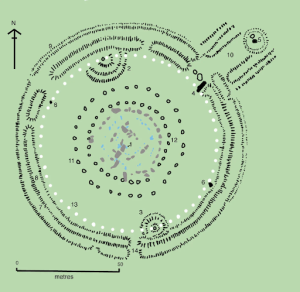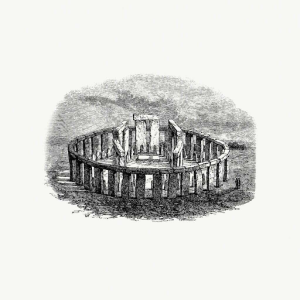Mysteries, Oddities, and Everything Strange: Stonehenge
January 27, 2023
Stonehenge: “Sarsen Standing Stones”
Great Britain is known worldwide for many things: tea and crumpets, bad teeth, puffy jackets, and an unconventional royal family are only a few of the many different stereotypes. Despite their eccentricity, Great Britain also contains pieces of history essential in understanding humanity’s past. One of these structures is Stonehenge, a circular figure made up of free-standing vertical boulders that are connected on the top by flat stones. The creation and purpose of this monument are unknown by most of the public, but its backstory is yet another reason to pique curiosity and intrigue.
 The structure is found in the southern portion of England on Salisbury Plain, nearby Salisbury, Wiltshire, England. It contains over 100 individual stones and reportedly took over 1,500 years to be fully constructed. It is about 5,000 years old and has puzzled historians, archeologists, and investigators throughout the world. Local tales described how the figure was created with magic by the mystical wizard Merlin, but those stories are completely fictitious. They describe how he hoisted the stones from Ireland to Salisbury Plain and enlisted the help of towering giants to construct the figure. Modern-day interpretations lean more towards aliens or other strange symbols, while more ancient tales suggest the remains of Romans or invaders.
The structure is found in the southern portion of England on Salisbury Plain, nearby Salisbury, Wiltshire, England. It contains over 100 individual stones and reportedly took over 1,500 years to be fully constructed. It is about 5,000 years old and has puzzled historians, archeologists, and investigators throughout the world. Local tales described how the figure was created with magic by the mystical wizard Merlin, but those stories are completely fictitious. They describe how he hoisted the stones from Ireland to Salisbury Plain and enlisted the help of towering giants to construct the figure. Modern-day interpretations lean more towards aliens or other strange symbols, while more ancient tales suggest the remains of Romans or invaders.
 The construction of the figure is rumored to have been completed by Neolithic Britons. They used deer antlers and other early tools that allowed them to etch the shape of the monument into the ground. Construction paused for hundreds of years before the stones were actually transported and oriented to create the clearing known today. Over one thousand years later, sandstone was contributed to Stonehenge in order to give it more structure, creating a ring around the circumference. Around 2600 B.C., wooden posts that were used to mark its dimensions were removed and replaced with around 80 more stones, completing the structure. After 3400 years, the final touches were made and the structure was left to be displayed as a token of hard work.
The construction of the figure is rumored to have been completed by Neolithic Britons. They used deer antlers and other early tools that allowed them to etch the shape of the monument into the ground. Construction paused for hundreds of years before the stones were actually transported and oriented to create the clearing known today. Over one thousand years later, sandstone was contributed to Stonehenge in order to give it more structure, creating a ring around the circumference. Around 2600 B.C., wooden posts that were used to mark its dimensions were removed and replaced with around 80 more stones, completing the structure. After 3400 years, the final touches were made and the structure was left to be displayed as a token of hard work.
The first modern investigation of Stonehenge began in the 1660s, when an archeologist by the name of John Aubrey surveyed the plain. This led more curious people to arrive and explore the figure. In the 1960s, an astronomer named Gerald Hawkins concluded that the stones created a calendar that aligned with various natural events like equinoxes and eclipses, but the people of the Bronze Age would lack the tools and abilities necessary to measure such phenomena.
 What was the actual purpose of Stonehenge? Historians are divided between two different explanations at this point in time. One hypothesizes that it was utilized as a religious site for ceremonies and rituals, while the other claims it observed the sky and surrounding natural features as a place for scientific exploration. Stonehenge is miraculously aligned with the sun and moon at certain points in time, which can explain either solution. It can either coincide with the winter and summer solstices or align with a calendar based on solar eclipses. Mike Parker Pearson, the leader of the Stonehenge Riverside Project and professor at Sheffield University, believes that it was a worship location due to its relation with the nearby River Aron. Bournemouth University’s Tim Darvill led an investigation in 2005 and discovered the quarry the stones originated from and that their movement could have partially been influenced by the Ice Age.
What was the actual purpose of Stonehenge? Historians are divided between two different explanations at this point in time. One hypothesizes that it was utilized as a religious site for ceremonies and rituals, while the other claims it observed the sky and surrounding natural features as a place for scientific exploration. Stonehenge is miraculously aligned with the sun and moon at certain points in time, which can explain either solution. It can either coincide with the winter and summer solstices or align with a calendar based on solar eclipses. Mike Parker Pearson, the leader of the Stonehenge Riverside Project and professor at Sheffield University, believes that it was a worship location due to its relation with the nearby River Aron. Bournemouth University’s Tim Darvill led an investigation in 2005 and discovered the quarry the stones originated from and that their movement could have partially been influenced by the Ice Age.
Today, Stonehenge is honored as a UNESCO World Heritage Site, which it was declared in 1986, and sees nearly 1 million visitors every year. There have been multiple projects throughout the years that were conducted to restore and excavate the area, which have led to the discovery of various other artifacts that surround the area. As of now, there is no immediate solution to the construction or purpose of Stonehenge, but it is an essential part of Great Britain’s cultural heritage and remains one of the most intriguing relics of ancient humans to date.
Resources:
https://www.britannica.com/topic/Stonehenge
https://www.history.com/topics/british-history/stonehenge
https://www.nationalgeographic.com/history/article/stonehenge-1?loggedin=true&rnd=1674609023501













































